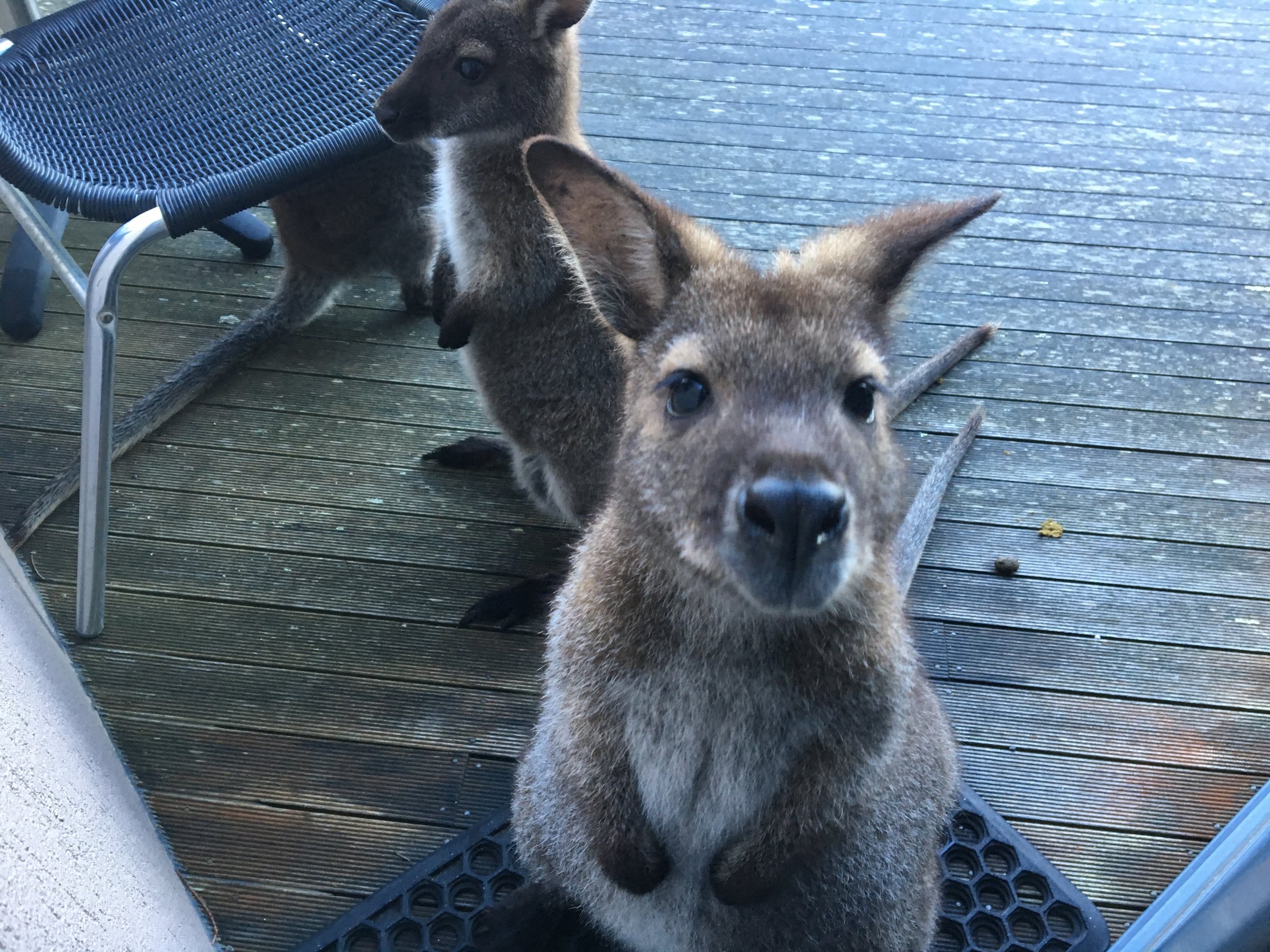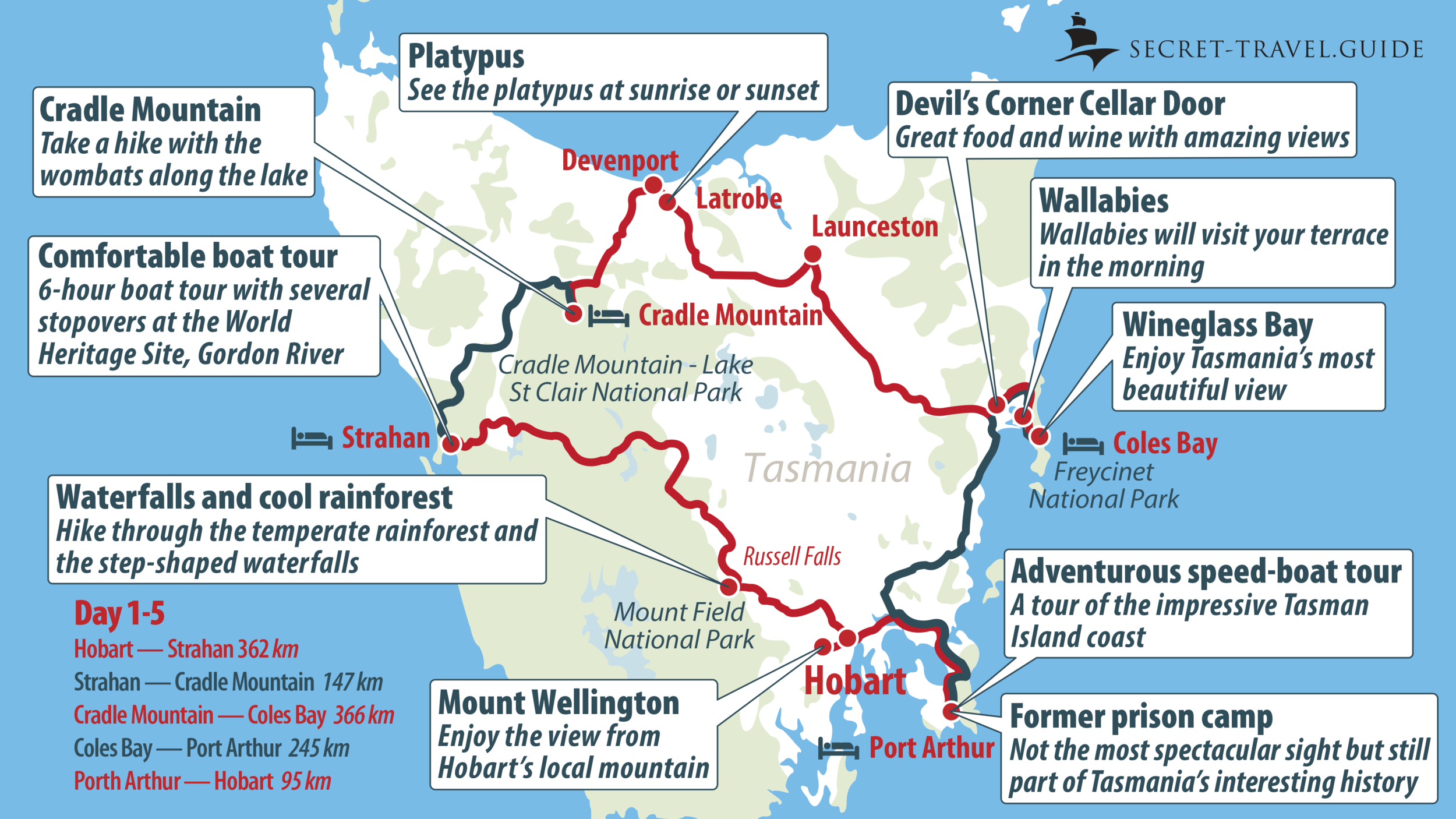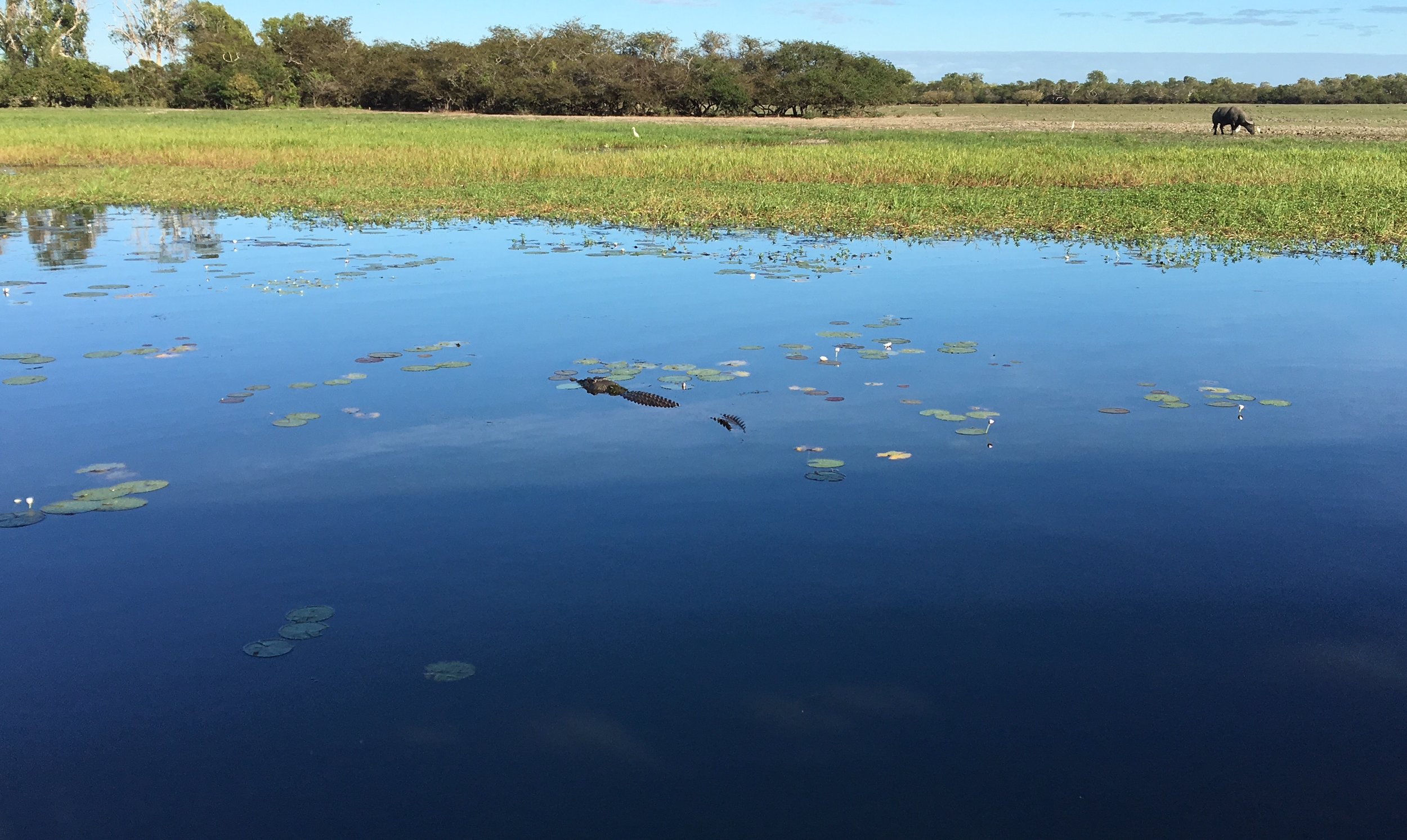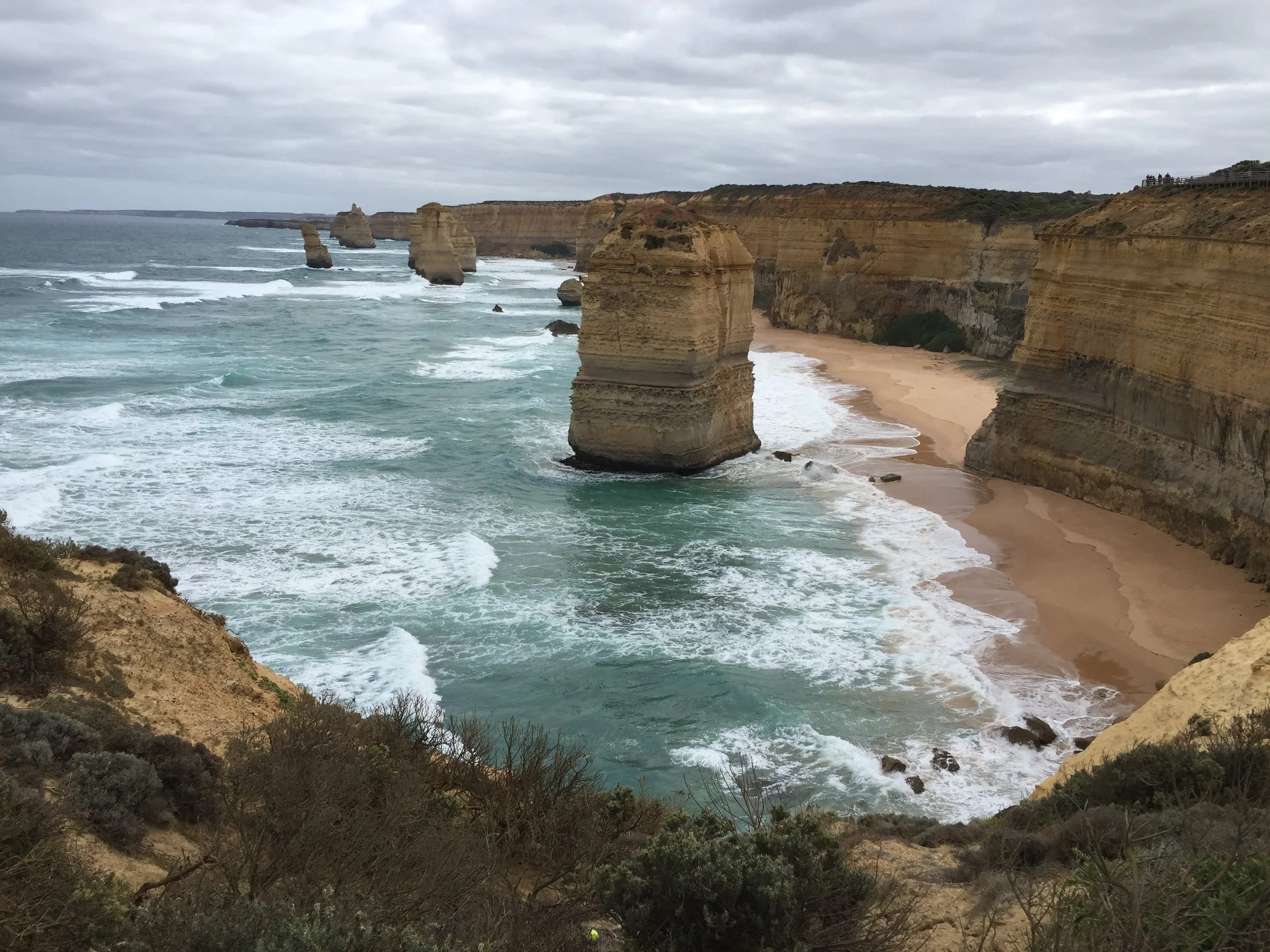Tasmania travel guide
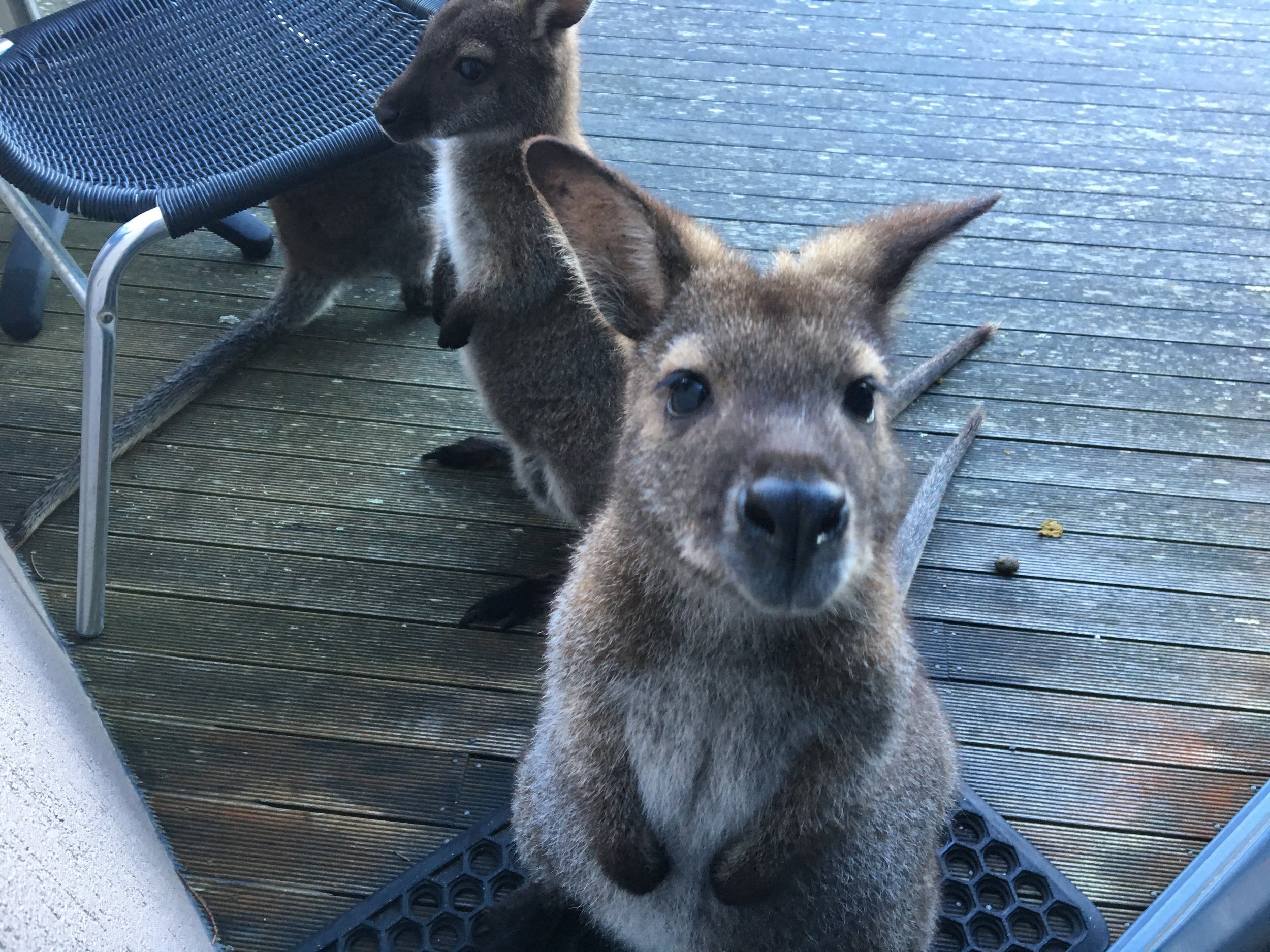






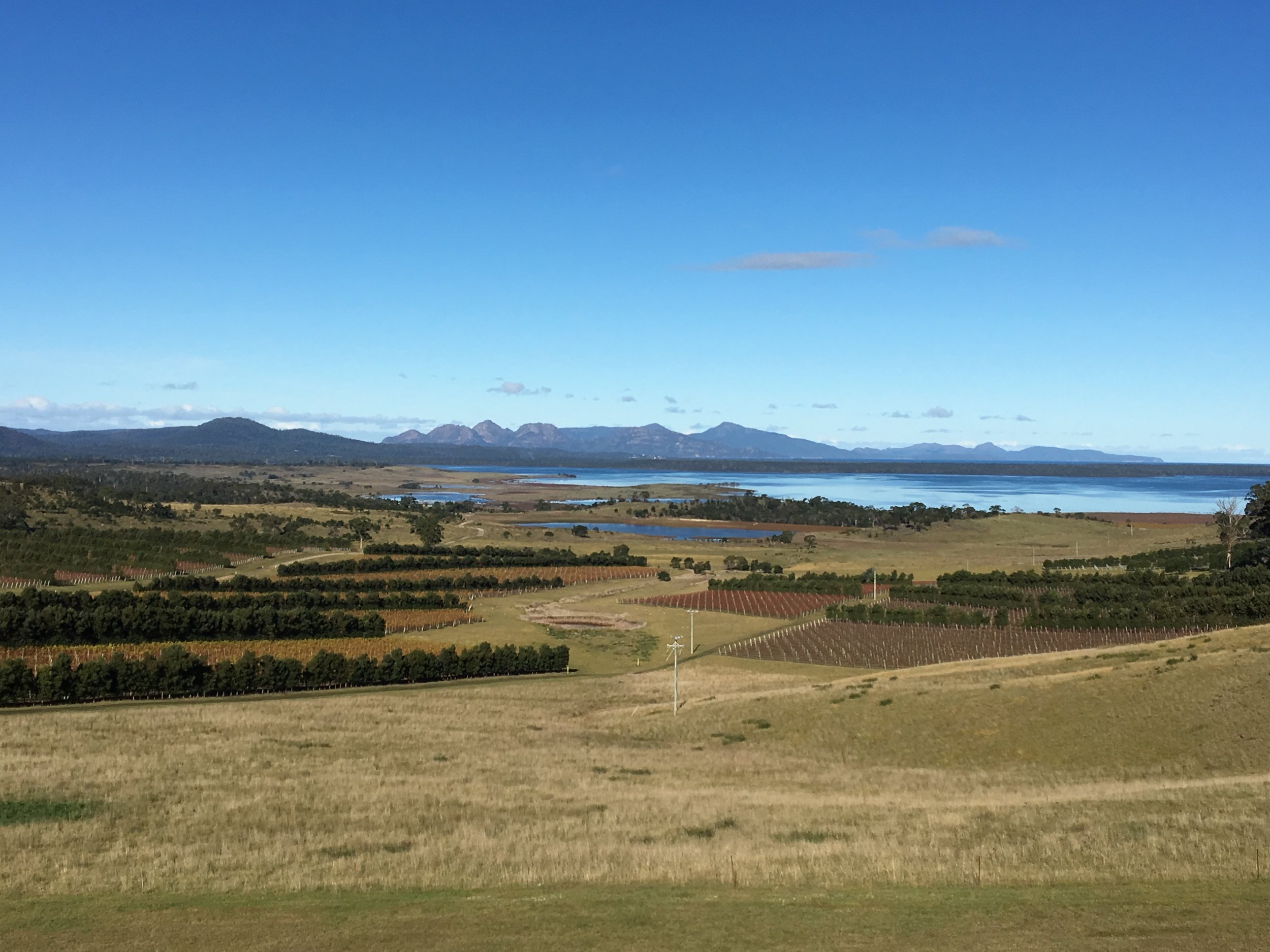

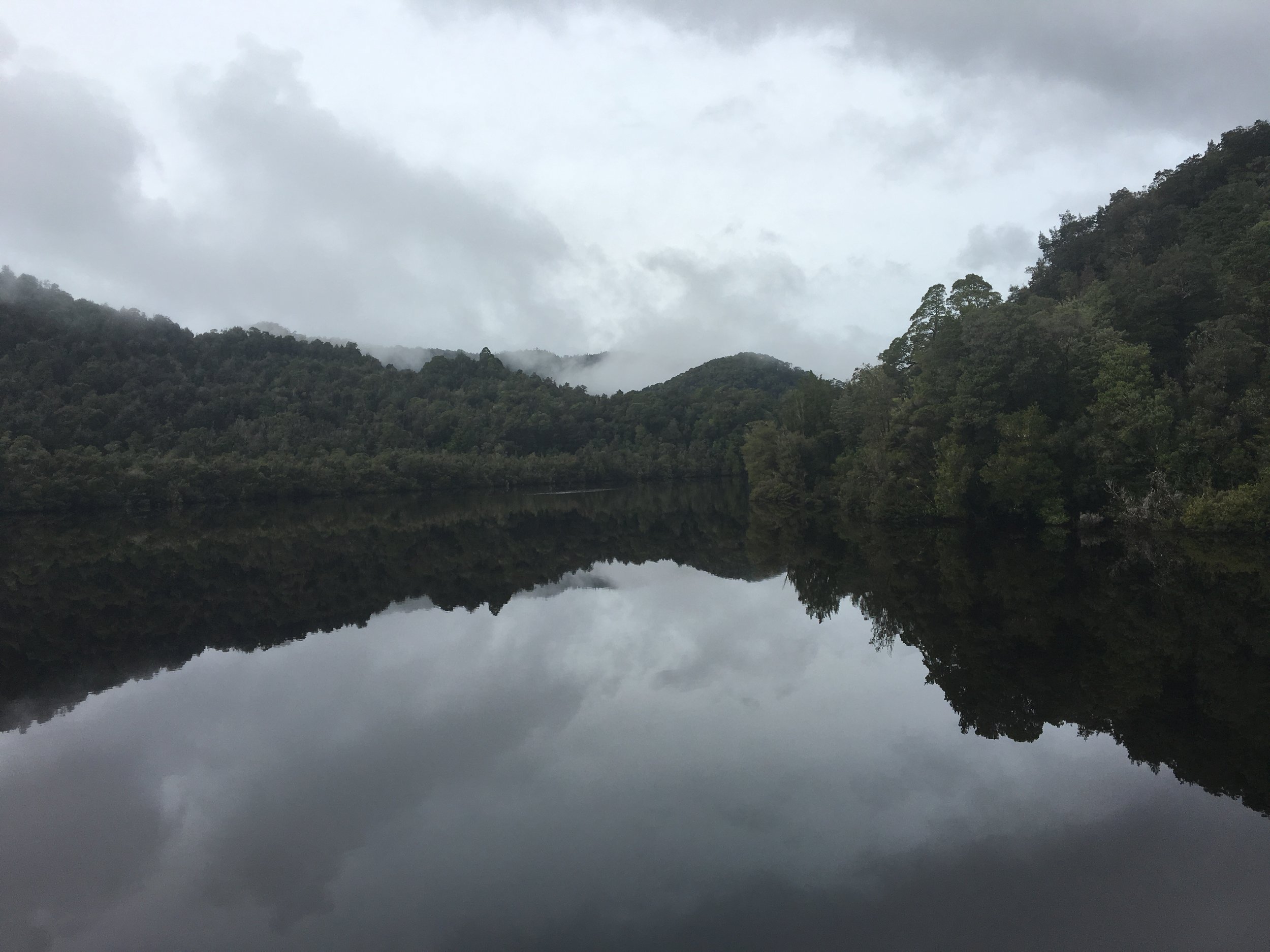



MAP OF TASMANIA
Tip: Download the road map of Tasmania to your smartphone as a picture. You can always use the Tasmania attractions map offline whenever you need it.
Why travel to Tasmania
Tasmania (Tassie) is one of the most magical destinations that has it all. Some of the biggest Tasmania attractions include its rugged mountains, vast beaches, and beautiful rainforests. If you are tempted to explore this southern Australian island, your Tasmania tours will have plenty of unforgettable adventures. After all, this is the only place in the world where you can find exotic animals like the Tasmanian Devil, wallabies, and many other endangered species.
Overview of what to see in Tasmania
- Tasmania’s cooler climate is a contrast to Australia’s and in some places, there is even snow due to the island’s proximity to Antarctica (2575 km).
- The island was once home to a prison for convicts
- Impressive wild nature and wildlife
- 4 -5 days are enough to tour the island, 1052 km from Hobart via Strahan, Cradle Mountain, Launceston, Freycinet, to Port Arthur.
- Tasmania is similar to New Zealand - due to its similar geographical location
- Tasmanian Devil - largest surviving predator and only found in Tasmania
- Lots of wombats and wallabies. In general, more species have survived in Tasmania compared to the mainland of Australia, as there are no dingoes and foxes.
Things to do in Tasmania
Your Tasmania holidays will consist of the following:
- From Hobart a total of 5 days' tour around Tasmania will be sufficient
- Enjoy a unique view of Hobart and the coast of Mount Wellington
- Hike through the cool temperate rainforest to see the unique waterfalls, "Russell Falls"
- Experience Tasmanian wildlife with wombats, opossums, Tasmanian devils, wallabies and much more
- In Strahan, take a speed-boat trip to Hell's Gate and along the World Heritage Site Gordon Rivers
- Take a hike to Cradle Mountain with unparalleled views of the Tasmanian mountains
- On your Tasmania trip, discover Platypus at sunrise or sunset
- Enjoy one of Tasmanian's most beautiful and memorable views of Wineglass Bay
- When you visit Tasmania, you will enjoy the impressive coastline with caves, waterfalls, rock formations, marine life and much more on a speedboat tour in Port Arthur
Tasmania facts
Where is Tasmania?
Tasmania, abbreviated as Tas, belongs to Australia and is located about 240 km south of the Australian mainland. A quarter of the island is designated as a UNESCO World Heritage Site and 37% of the island consists of national parks.
The Antarctic is in close proximity
Tasmania, and especially western Tasmania, is cooler than the mainland of Australia. The rainfall in western Tasmania is also heavier than in the east due to its mountain ranges. In the east, on the other hand, the sun usually shines most of the day. The average temperatures in the summer are between 9 ° C and 19 ° C and in winter between 0.5 ° C and 10.5 ° C. In winter, frost is not uncommon and the hilltops can sometimes get covered with snow.
Abrupt weather changes, strong wind and high humidity are also on the itinerary in Tasmania. In contrast to the mainland, Tasmania is exposed to violent west winds, which prevail at this latitude throughout the southern hemisphere. Westerlies unrestrictedly pass through Tasmania as no landmasses are surrounded. Because of this and the cold Antarctic ocean current (distance to the Antarctic 2575 km), the west of Tasmania is wetter, colder and has less hours of sunshine than the East.
Where to travel in Tasmania
Day 1
Australia's second oldest city - Hobart
One of the best places to visit in Tasmania has to be Australia's second oldest city - Hobart. Hobart is the capital of Tasmania and the second oldest city in Australia after Sydney (founded in 1803 as a penal colony).
Hobart's Harbour is the second deepest natural harbour in the world and is a strategic gateway to the Southern Ocean and Antarctic. The proximity to the Antarctic makes itself felt at the port with the impressive pirate ships and the Institute for Marine and Antarctic Studies (IMAS) and are definitely worth a stopover.
Hobart is also appealing with an excellent restaurant scene and first class breakfast cafes. A must is the Italian restaurant, Da Angelo. Especially nice is the area around the Battery Point, which is called the "old Hobart" by the locals.
Mount Wellington
Once in Hobart, the first thing to do is to visit Mount Wellington. The 1269 metre high Mount Wellington is the landmark of Hobart. It is 22 km away from Hobart. At the top there is a lookout point near the summit, from where you can see the entire Derwent estuary as well as Hobart, the Tasman Peninsula and a basalt cliff.
Russell Falls Waterfall
Afterwards, you can visit Mount Field National Park and Russell Falls and Horseshoe Falls. You can reach Russell Falls on foot in about 10 minutes. If you have a little more time, you can continue your walking tour towards the smaller waterfall called, Horseshoe Falls. From the Horseshoe Waterfall you can go back to the car park via the Tall Trees Circuit and the Tall Trees Walk. On this route you can mainly see giant eucalyptus trees (swamp gums). All in all, the walking tour will take about 60 minutes.
Mount Field National Park has many beautiful sights to offer. However, as today’s trip is going to continue to Strahan, you should not stay in the park too long, because there are much more places to visit in Tasmania.
Day 2: Gordon River, a World Heritage Site
Today you can take a boat trip from Strahan to Hells Gate, Sarah Island and along the world heritage Site, Gordon Rivers. The guided boat tour starts at the harbour in Strahan and takes about 6 hours.
Hells Gate
The first stop is the Hells Gate gorge, which provides access to Macquarie Harbour, where Strahan is located. The gorge is known for its treacherous currents and shallow waters. Hells Gate's name comes from the inmates, who were imprisoned on Sarah Island and regarded this gorge as their private gateway to hell. On the way back from Hells Gate in the direction of Sarah Island you will pass a local fish farm and learn about the history of salmon and trout farming on the west coast of Tasmania.
Sarah Island
The next stop on our list of top Tasmania resorts is Sarah Island, home to the former British penal colony "Macquarie Harbour Penal Station". You can spend about 1 hour on the island and learn about its history.
Gordon River
The final leg of the boat trip goes along the Gordon River with a stop at the "temperate" rainforest. Gordon River is known for attracting tourists perhaps because of its horseshoe shape. Just before this horseshoe, there is an entrance to the "temperate" rainforest, through which you can stroll for about 30 minutes and learn about the local flora and fauna. Afterwards you can return to the harbour in Strahan.
After the boat trip, head towards Cradle Mountain. Once in Cradle Mountain, if you still feel like it, you can join a "Night Wildlife Tour".
Night Wildlife Tour
This is a nightly tour of the national park in search of Tasmanian animals. You will see wombats, possums and wallabies as well as Pademelon Wallabies. These very small Wallabies that are only found in Tasmania. If you are lucky you might even see a Tasmanian devil.
Day 3: Experience Tasmania's mountains
Cradle Mountain - Lake St Clair National Park
Cradle Mountain offers enticing walks for everyone. A good option is to tour for around 2 hours (6.2 km) through "Dove Lake". Alternatively, you can hike to the summit of Cradle Mountain in about 6 -8 hours (12.8 km). For those looking for something in between, we recommend the route from Dove Lake Car Park, via Wombart Pool to Marions Lookout. Marions Lookout offers beautiful views of Cradle Mountain and Dove Lake and Crater Lake. From Marions Lookout the trail goes back down towards Dove Lake. Once you reach the bottom of the lake, you will pass a small boathouse before you reach the car park again. The whole trail takes about 2 - 3 hours. Overall, we felt that we had plenty of time to explore all the routes. For example, the tour to the Marions Lookout takes 3 hours, but it can also be done within 2 hours. We strolled comfortably for just over 2 hours and took a lot of photos along the way.
You can also go to the tourist information centre for further tours or book a guided tour. We do not recommend starting the trip in the morning after 10:00 o'clock. You should take a "small" tour of about 2 - 3 hours, as the journey continues afterwards.
Peppers Cradle Mountain Lodge is highly recommended. This is a very nice lodge with its own fireplace in the room, a great restaurant, spa and many tours offered, such as the Night Wildlife Tour.
Devenport
On the way to Launceston you can plan a short stop in Devenport and look at the Mersey Bluff lighthouse.
Platypus
The village of Latrobe is known for its platypus, which is not found anywhere else in in the world other than in Latrobe. Platypuses are especially active at sunrise or sunset, so these are the best times to see them. You can find them in the Warrawee Forest Reserve in Latrobe. Note: The Google Maps search for Warrawee Forest Reserve does not work, but you can reach Warrawee Forest in 3.5 km via Gilbert Street, Latrobe.
Launceston
Anyone who wants to can plan a short trip to the second largest city in Tasmania. Launceston is great for a spot of lunch or coffee before heading off to Coles Bay for a night out.
Day 4: Enjoy Tasmania's most beautiful view
One tip for an overnight stay in Coles Bay is the Edge of the Bay Lodge. Edge of Bay Lodge is a modern lodge just outside the village of Coles Bay, right on the beach. We would like to recommend this lodge as a top Tasmania accommodation, especially because we were greeted in the morning by wallabies on our terrace. These wallabies seem to be very used to people and are very trusting as they hope to get fed. This is your opportunity to hand feed wallabies. From the terrace you also enjoy a direct view of the beach and the pink granite rocks behind it. The Freycinet National Park is known for its pink granite rocks called "The Hazards".
360 degree view over Tasmania's most beautiful bay
A beautiful view of the famous Wineglass Bay can be enjoyed from the Wineglass Bay Lookout. From the car park (Wineglass Bay Carpark) you need about 60 minutes to get there and back.
A much more demanding, but a more beautiful view to enjoy is Mount Amos. It takes about 3 hours to get there and back, but you will be rewarded with a 360-degree view over the entire Wineglass Bay. The view is breathtaking and definitely worth the effort. Mount Amos itself is one of the three granite mountains on the Freyinet Peninsula and 485 feet high.
Aussicht von Mount Amos
First class food and wine
If you are hungry after the hike, you should definitely visit Tombolo Devils Corner (Sherboune Road, Apslawn). At this restaurant, you will not only find first-class wine from the region, but also very good pizzas and fish and chips. Your food and drinks can be enjoyed with a beautiful view of the sea, the granite rocks and the countryside.
Today you should continue your Tasmania tour to Port Arthur and stay there overnight.
Day 5: Adventurous speedboat tour along Tasmania's coast
In Port Arthur you should not miss out on a speedboat tour along the coast to Tasman Island.
The tour starts in Port Arthur and goes along the coast to the small Tasman Island. During the entire trip, which lasts about 3 hours, you will be rewarded with unique views of the coast, waterfalls, unique rock formations, deep-sea caves, but also seals, albatross, white-tailed eagles, cormorants, peregrine falcons and seabirds. If you are lucky you can also see dolphins and whales.
The tour was our personal favourite in our Tasmania trip. Don't be surprised if the 3 hour tour goes quickly, as one natural beauty is followed by another.
To make this experience even better, here are a few tips:
- Sit at the right side of the boat
As you tour uphill towards the coast of Eagles Neck in the direction of Tasman Island the coast will be on the right. On the way there, you will stop over at all the attractions so you will have time to take photos. On the way back you will be passing through the same route again. That means you can spend much longer on the way there and enjoy the best view from the right seat. - Wear warm clothes
According to the boat crew, it's up to 10 degrees colder at the lake. You will be given a raincoat that goes down to your feet, just in case. Nevertheless, one should wrap up well because it can get very chilly. - Take something for "seasickness"
The boat is very shaky and not suitable for people who are prone to seasickness. At the beginning of the tour ginger tablets are handed out for nausea. In any case, there are plenty of exit points along the boat ride if your stomach doesn't feel up to it. - Sit at the front of the boat
For those of you who do not have problems with motion sickness, the front seats of the boat are definitely the best. Here the boat wobbles and you will feel as though you are in a roller coaster. The fun part is definitely at the front of the boat with better views. - Sit at the back of the boat
It is recommended to sit in the back if you have back, hip or knee problems, get seasick easily or travel with children. The advantage is also that the rear seats are covered and therefore less exposed to wind and rain.
Port Arthur viewpoints
If you do not feel like taking a boat trip, you can also reach some of the impressive rock formations and caves on foot or by car. Especially worth seeing are Tasman Arch, Blow Hole, Devil's Kitchen, Tessellated Pavement, Remarkable Cave, Waterfall Bay and the Maingon Bay Lookout. But if you take a boat trip, you can see all of these within one tour.
Port Arthur penal camp
Personally, we found the former penal camp less spectacular, but it is still part of the history of Tasmania and worth a visit.
The former penal camp is World Heritage Site and the best preserved penal camp in Australia. Here you can see more than 30 buildings, ruins and restored houses and 40 hectares of landscaped gardens.
FAQs
How to travel to Tasmania?
There are regular flights from Sydney, Melbourne, and Brisbane. Alternatively, you can hire a car, motorhome, or a camper van for your Tasmania trip.
Can you explore Tasmania without a car?
It is not recommended to travel to Tassi without a car or camper, especially if you make a round trip. Public transportation is not an option.
Is there a ferry to Tasmania?
Yes. One of the most enjoyable ways to explore Tasmania Island is via the Spirit of Tasmania ferry. There are also other cruise ships with deluxe cabins as well as reclining chairs for the budget-conscious.
What is the Population of Tasmania and its official currency?
Around 519,155, with almost 5,500 people added to the overall population each year. The official currency is the Australian dollar.
Where is Bay of Fires Tasmania?
The Bay of Fires is on the northeastern coast of Tas and extends from Binalong Bay to Eddystone Point. You can take a walk for hours through this bay’s sandy beaches and swim in the ocean whilst enjoying the magnificent views.
When is the best time to travel to Tasmania?
Tasmania weather is changeable, but thanks to its four seasons, you can explore it at any time of the year. If you want to see more of the wildlife, for example, the months of May, June, July, September, and October are the best time to visit. For hiking fans, August is a good time to go. But if you want a quieter holiday without all the crowds, opt for March or April.

